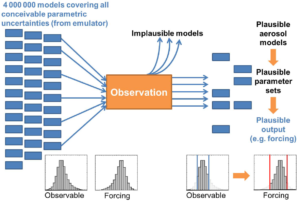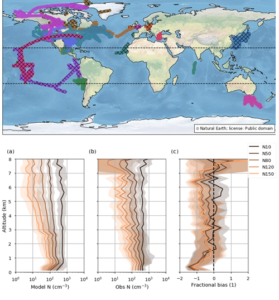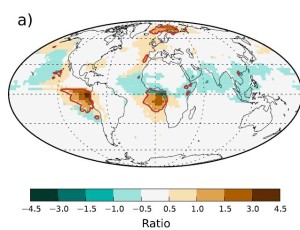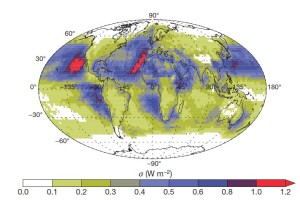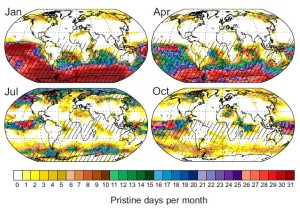Summary of key findings and results
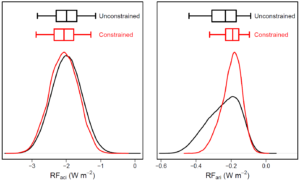 Simulated range of ACI (left) and ARI (right) forcings before (black) and after (red) constraint is applied.
Simulated range of ACI (left) and ARI (right) forcings before (black) and after (red) constraint is applied.
Constraining models to reduce uncertainty in climate projections
Observational constraint of model uncertainty is a process in which scientists compare output from many variants of a model to in-situ and satellite observations in a systematic way, in order to understand and rule out model parameter settings which produce output that is “implausible” (i.e. those that produce output that is too far away from observed values to be correct). It is a way of understanding which values of unknown parameters give realistic output. Observational constraint of climate models is an important step to try and reduce the uncertainty in climate predictions.
Johnson et al (2020) used over 9000 monthly aggregated grid-box measurements of aerosol (including data from the GASSP database) to constrain the uncertainty in the HadGEM3-UKCA climate model. Measurements of AOD, PM2.5, particle number concentrations, sulphate and organic mass concentrations are compared to 1 million ‘variants’ of the model using an implausibility metric. Despite many compensating effects in the model, the procedure constrains the probability distributions of many parameters and direct radiative forcing uncertainty (ARI) is reduced by 34%. However, the constraint on the aerosol-cloud radiative (ACI) forcing uncertainty is much weaker, only reducing by 6%.
Schematic of the process used to constrain the model; moving from 4 million varients on the left, to a much reduced collection of “plausible” models on the right. The resulting change in forcing is shown in the bar charts.
Demonstrating constraint using “synthetic” observations
Observational constraint of simulated aerosol and cloud properties is an essential part of building trustworthy climate models for calculating aerosol radiative forcing. Models are usually tuned to achieve good agreement with observations, but tuning produces just one of many potential variants of a model, so the model uncertainty cannot be determined. In this paper by Johnson et at (2018) we estimate the uncertainty in aerosol effective radiative forcing (ERF) in a tuned climate model by constraining 4 million variants of the HadGEM3-UKCA aerosol–climate model to match nine common observations (top-of-atmosphere shortwave flux, aerosol optical depth, PM2.5, cloud condensation nuclei at 0.2?% supersaturation (CCN0.2), and concentrations of sulfate, black carbon and organic carbon, as well as decadal trends in aerosol optical depth and surface shortwave radiation.)
The model uncertainty is calculated by using a perturbed parameter ensemble that samples 27 uncertainties in both the aerosol model and the physical climate model, and we use synthetic observations generated from the model itself to determine the potential of each observational type to constrain this uncertainty.
Schematic showing the locations of the observations used (top) and the range of vertical distributions of aerosol number from the model compared to observations (bottow).
Aerosols at altitude: Understanding the vertical distribution of aerosol
Although we know a lot about the distribution of aerosol close to the surface, much less is known about how the concentrations of aerosol vary at higher altitude; this is important as it is aerosol above the surface that most affects the properties of clouds, which has an effect on the climate. In this paper, led by Duncan Watson-Parris at the University of Oxford, the GASSP database is used to investigate the how the vertical structure of submicron aerosols varies across a wide range of regions and environments. The database contains data from over 1000 flights from 37 campaigns from around the world. Data from the GASSP dataset was compared to output from the ECHAM-HAM global aerosol and climate model, this revealed that the model underestimates accumulation-mode particles in the upper troposphere, especially in remote regions. The processes underlying this discrepancy were explored using different aerosol microphysical schemes and a process sensitivity analysis. This showed that the biases are predominantly related to aerosol ageing and removal rather than emissions.
A rigorous approach to model constraint
In a paper in the Proceedings of the National Academy of Sciences, we present the first attempt to rigorously constrain an aerosol model, then examine the implications for forcing uncertainty. This paper was based on a keynote presentation at the Sackler Colloquium in 2015. In GASSP, “constraint” means generating a huge ensemble of model simulations that sample all important uncertainties, then retaining only those simulations that are plausible when compared to measurements. Rather than finding the best model, we retain all plausible model variants, which allows us to quantify the remaining model uncertainty. A key discovery in this paper by Lee, Reddington and Carslaw is that a global aerosol microphysics model has very high equifinality. This means that, for example, similar aerosol concentrations are predicted by a wide range of model variants (i.e., different parameter settings). We show that these model variants can simulate very different aerosol forcings, so tight constraint of the aerosol model doesn’t feed through directly to forcing uncertainty.
Uncertainty in regional and decadal forcing
In two papers written by Leighton Regayre et al. (GRL 2014, J Climate 2015) during his PhD we have explored the causes of uncertainty in regional patterns of aerosol-cloud forcing over recent decadal periods. There are several important results for GASSP. First, we found that the causes of uncertainty are very different over decadal periods than since the pre-industrial. Natural aerosols are much less important, which suggests the uncertainty may be more easily reduced. Second, the uncertainty in regional forcing can be very high, which might affect regional climate change. Third, the causes of uncertainty in regional forcing are very different to the causes of uncertainty in global mean forcing. So significant regional uncertainty might persist even if we could reduce uncertainty in the global mean. See DOI: 10.1175/JCLI-D-15-0127.1 and doi: 10.1002/2014GL062029.
Importance of natural aerosols in forcing uncertainty
In Carslaw et al. (Nature, 2013), we showed that natural aerosols have a substantial effect on the uncertainty in pre-industrial to present-day aerosol-cloud forcing. Twenty-eight uncertain aerosol parameters were sampled in the GLOMAP model using a perturbed parameter ensemble (PPE) and model emulation. Over 40% of the forcing uncertainty is due to natural aerosol emissions, even though the emissions are assumed to be constant over the industrial period. The reason for the large contribution to uncertainty is that natural aerosols define the baseline aerosol state from which forcing is calculated, and cloud albedo is highly sensitive to aerosol concentrations in pristine environments. The importance to GASSP is that our ability to reduce uncertainty in forcing depends on the availability of aerosol measurements under pristine pre-industrial-like conditions. See doi:10.1038/nature12674.
Finding pristine aerosol environments
In a paper by Douglas Hamilton et al. (PNAS, 2014) produced during his PhD, we used a novel approach to identify regions of the planet where aerosol conditions can still be considered pristine. These are highly valuable locations for making aerosol measurements because they are representative of the natural aerosol background, which has a large effect on forcing uncertainty (Carslaw et al., 2013). GASSP has prioritised the collection of measurements in such pristine environments, but they are comparatively rare. See www.pnas.org/cgi/doi/10.1073/pnas.1415440111.
We have a list of published papers.






